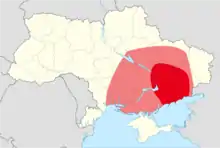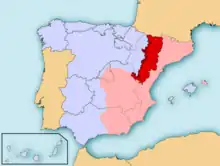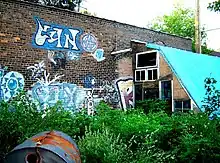| Part of a series on |
| Anarchism |
|---|
 |
This is a list of anarchist communities representing any society or portion thereof founded by anarchists that functions according to anarchist philosophy and principles. Anarchists have created and been involved in a plethora of community experiments since the 19th century. There are numerous instances in which a community organizes itself along philosophically anarchist lines to promote regional anarchist movements, counter-economics and countercultures. These have included intentional communities founded by anarchists as social experiments and community-oriented projects, such as collective organizations and cooperative businesses. There are also several instances of mass society "anarchies" that have come about from explicitly anarchist revolutions, including the Makhnovshchina in Ukraine, Revolutionary Catalonia in Spain and the Shinmin autonomous region in Manchuria.
Mass societies
Active societies
| Flag | Society | Since | Duration | Location | Ideology | Ref. |
|---|---|---|---|---|---|---|
| Freetown Christiania | 1971 (September 26) | 52 years, 109 days | Copenhagen, Denmark | Anarchism | [1][2] |
Past societies


| Flag | Society | From | Until | Duration | Location | Ideology | Ref. |
|---|---|---|---|---|---|---|---|
| Strandzha Commune | 18 August 1903 | 8 September 1903 | 21 days | Strandzha, Ottoman Empire | Libertarian communism | [3] | |
| Baja Rebellion | 29 January 1911 | 22 June 1911 | 144 days | Baja California, Mexico | Magonism | [4] | |
| Soviet Republic of Naissaar | 17 December 1917 | 26 February 1918 | 71 days | Naissaar, present-day Estonia | Anarcho-syndicalism | [5] | |
| Southern Fujian Protectorate | 1 September 1918 | 12 August 1920 | 1 year, 346 days | South Fujian, China | Anarchism, Socialism | [6] | |
| Makhnovshchina | 27 November 1918 | 28 August 1921 | 2 years, 274 days | Ukraine | Anarcho-communism, Platformism | [7] | |
| Korean People's Association in Manchuria | 3 August 1929 | 18 September 1931 | 2 years, 46 days | Manchuria, China | Anarchism | [8] | |
| Revolutionary Catalonia | 21 July 1936 | 10 February 1939 | 2 years, 204 days | Catalonia, Spain | Anarcho-syndicalism | [9] | |
| Regional Defence Council of Aragon | 6 October 1936 | 11 August 1937 | 309 days | Aragon, Spain | Anarcho-communism | [9] | |
Intentional communities
Active communities:

- Stapleton Colony (1921–present)[10]
- Longo Mai (1973–present)
- Awra Amba (1980–present)[11]
- Acorn Community (1993–present)[12]
- Trumbullplex (1993–present)[13]
Past communities:
- Utopia (1847–1875)[14]
- Modern Times (1851–1864)[15]
- Cecília Colony (1890–1893)[16]
- Home (1895–1919)[17]
- Equality Colony (1897–1907)[17]
- Whiteway Colony[18] (1898)[19]
- Poole's Land (1988–2020)
- Tenacious Unicorn Ranch (2018–2023)
Community projects
Active Projects
- The 1 in 12 Club (1981–present)
- ABC No Rio (1980–present)
- ACU (1976–present)
- Bluestockings (1999–present)
- The Brick House (1999–present)
- Camas Bookstore and Infoshop (2007–present)
- Can Masdeu (2001–present)
- Can Vies (1997–present)
- Cascina Torchiera (1992–present)
- Centre International de Recherches sur l'Anarchisme (1957–present)
- Ché Café (1980–present)
- Civic Media Center (1992–present)
- Coffee Strong (2008–present)
- Common Ground Collective (2005–present)
- Cowley Club (2003–present)
- CSOA Forte Prenestino (1986–present)
- C-Squat (1989–present)
- Dial House (1970–present)[20]
- DIY Space For London (2015–present)
- Eskalera Karakola (1996–present)
- Extrapool (1991–present)
- Firestorm Cafe & Books (2008–present)
- Forest Café (2000–present)
- Freedom Press (1886–present)
- Freedom Shop (1995–present)
- Grote Broek (1984–present)
- Hausmania (2000–present)
- Hirvitalo (2006–present)
- Jura Books (1977–present)
- Kafé 44 (1976–present)
- Kulturzentrum Bremgarten (1990–present)
- Landbouwbelang (2002–present)
- London Action Resource Centre (1999–present)
- Lucy Parsons Center (1992–present)
- Metelkova (1993–present)[21]
- Noisebridge (2007–present)
- OCCII (1982–present)
- OT301 (1999–present)
- Poortgebouw (1980–present)
- Red Emma's Bookstore Coffeehouse (2004–present)
- Rote Flora (1989–present)
- Rozbrat (1994–present)
- Slab City, California (c. 1961-present)
- Spartacus Books (1973–present)
- Sumac Centre (1984–present)
- The Old Market Autonomous Zone (1995–present)
- Turun Kirjakahvila (1981–present)
- UFFA (1981–present)
- Warzone Collective (1984–present)
Past Projects
- 121 Centre (1981–1999)
- 491 Gallery (2001–2013)
- ADM (1997–2019)
- ASCII (1999–2006)
- Bank of Ideas (2011–2012)
- Binz (2006–2013)
- BIT (1968–1979)
- Bloomsbury Social Centre (2011)
- Boxcar Books (2001–2017)
- Brian MacKenzie Infoshop (1999–2008)
- Capitol Hill Autonomous Zone (2020)
- Catalyst Infoshop (2004–2010)
- Centro 73 (2010)
- Centro Iberico (1982)
- Cream City Collectives (2006–2012)
- De Blauwe Aanslag (1980–2003)
- Factory Rog (2006–2021)
- Internationalist Books (1981–2016)
- Iron Rail Book Collective (2003–2012)
- Klinika (2014–2019)
- Kukutza (1996–2011)
- Kunsthaus Tacheles (1990–2011)
- Patio Maravillas (2007–2015)
- rampART (2004–2009)
- Really Free School (2011)
- Red and Black Cafe (2000–2015)
- RHINO (1988–2007)
- Salon Mazal
- Seomra Spraoi (2004–2015)
- Spike Surplus Scheme (1999–2009)
- Squat Milada (1997–2009)
- St Agnes Place (1969–2005)
- Ungdomshuset (1982–2007)
- Villa Amalia (1990–2012)
- Vrijplaats Koppenhinksteeg (1968–2010)
- Wapping Autonomy Centre (1981–1982)
See also
- Lists of ungoverned communities
- List of socialist states
- Communist state
- List of stateless societies
- Temporary Autonomous Zone – a community that is autonomous from the generally recognized government or authority structure
- Zomia – the ungoverned highlands of Southeast Asia, held as an analogous anarchist society by professor James C. Scott
- Bruderhof Communities - Christian Communes based in the Hutterite tradition
References
- ↑ Bamyeh, Mohammed A. (May 2009). Anarchy as order. Lanham, Maryland: Rowman & Littlefield. p. 21. ISBN 978-0-7425-5673-7.
[A]nti-authoritarian sentiments reemerged as part of a larger universe of visions of an alternative society, including antimilitarism, civil rights, more sexual freedom, and some communal experimentations with self-governance—a surviving example of which today is Freetown Christiania in Denmark.
- ↑ Frater, Jamie (1 November 2010). Listverse.com's Ultimate Book of Bizarre Lists. Berkeley, CA: Ulysses press. pp. 516, 517. ISBN 978-1-56975-817-5.
Depending on who you talk to, Freetown Christiania is either "the world's first fully-functioning anarchist society" or an area overrun with squatters and drug dealers.
- ↑ Khadzhiev, Georgi (1992). "The Transfiguration Uprising and the 'Strandzha Commune': The First Libertarian Commune in Bulgaria". Nat︠s︡ionalnoto osvobozhdenie i bezvlastnii︠a︡t federalizŭm [National Liberation and Libertarian Federalism] (in Bulgarian). Translated by Firth, Will. Sofia: Artizdat-5. pp. 99–148. OCLC 27030696.
As far as the economic system of the Strandzha Commune was concerned, it can only be described as being libertarian communist.
- ↑ "Uprising in Baja California" (PDF). Anarchist Federation. Archived (PDF) from the original on 4 August 2012. Retrieved 7 June 2013.
- ↑ Popławski, Kazimierz (6 November 2017). "Naissar: the Estonian "Island of Women", Once an Independent Socialist Republic". Deep Baltic. Translated by Ostrowska, Martyna. Archived from the original on 16 July 2019. Retrieved 16 July 2019.
Soon after the outbreak of the October Revolution, on 17th December 1917, the crew of the warship Petropavlovsk (later named Marat) and the builders of the fortress seized power on the island. They announced the creation of an independent socialist republic. [...] An anarcho-syndicalist of Ukrainian origin, Stepan Maksimovich Petrichenko, became the leader of the Council of Peoples' Commissars. [...] The Council is said to have declared "in accordance with the law, Naissaar is now an independent (Soviet) republic." [...] The black and red banner of the anarcho-syndicalists became the flag of the new republic.
- ↑ Chen, Leslie H. (2000). "Chen Jiongming: Anarchism and the Federalist State". Center for Chen Jiongming Studies. Alexandria, Virginia. Archived from the original on 11 March 2007.
Chen continued to be the patron and protector of his anarchist friends and comrades who now engaged in a social and cultural reform movement in Canton. During the May Fourth period, Chen created with the help of anarchist intellectuals a "model" city of New Culture in Zhangzhou, Fujian, which won the critical acclaim both in China and abroad. Back in Guangdong in the 1920s, Chen actively promoted peaceful unification of the country through "Chinese federalism" - a "bottom-up" form of federalism that clearly has its anarchist origin.
- ↑ Skirda, Alexandre (2004). Nestor Makhno: Anarchy's Cossack. AK Press. p. 3. ISBN 1-902593-68-5.
- ↑ Hwang, Dongyoun (2016). "Experimenting Place-Based Anarchism in Manchuria". Anarchism in Korea: Independence, Transnationalism, and the Question of National Development, 1919-1984 (PDF). Albany, New York: SUNY Press. pp. 48–55. ISBN 978-1-4384-6167-0. OCLC 1039293708.
The USAKP has been highly evaluated by Korean anarchists as the embodiment of anarchist principles, because it seemed to have its own seeming territorial jurisdiction. As shown in its two goals to improve the economic and political status of Koreans in Manchuria and to concentrate their capacity on completing saving the nation through resisting Japan, strictly speaking, it was not an anarchist organization. It rather defined itself in its platform as "an autonomous, self-ruling, cooperative organization" that had its own distinctive jurisdiction, similar to its predecessor, the LKAM. In particular, the USAKP's plans for agricultural development, education, and military training within its jurisdiction, as well as for its representative system along with its administrative body, have all been praised as a reflection of the anarchist ideal of "a government without [compulsory] government" that assured the principles of no-rule, no-naked power, and no-exploitation.
- 1 2 Dolgoff, Sam (1974). The Anarchist Collectives: Workers' Self-Management in the Spanish Revolution, 1936–1939.
- ↑ Hardy, Dennis (2000). Utopian England: Community Experiments, 1900-1945. Psychology Press. p. 181. ISBN 978-0-419-24670-1.
- ↑ "Awra Amba: the anarcho-feminist utopia that actually works". 3 October 2016. Archived from the original on 11 October 2018. Retrieved 11 October 2018.
- ↑ "Searching For Happiness In 'Utopia'". Huffington Post. Archived from the original on 3 March 2016. Retrieved 11 March 2016.
Acorn Community Farm [is] a self-described "farm-based, anarchist, eco-conscienced, secular, egalitarian community"
- ↑ Osborne, Domenique (9 November 2002). "Radically wholesome". Metro Times. Archived from the original on 30 March 2011. Retrieved 13 April 2011.
the Trumbullplex [is] a Cass Corridor anarchist collective
- ↑ Martin, James J. (1970) [1953]. Men Against the State: The Expositors of Individualist Anarchism in America, 1827-1908. Colorado Springs: Ralph Myles Publisher. ISBN 9780879260064. OCLC 8827896.
[T]he second essay in anarchist community life, variously known as "Utopia" and "Trialville," was begun on a tract of land on the bank of the Ohio River about a mile from the site of the Clermont Phalanx. The labor exchange ideal prevailed from the beginning.
- ↑ "An Experiment in Anarchy: Modern Times, the notorious and short-lived utopian village that preceded Brentwood". Archived from the original on 9 August 2014.
- ↑ Marshall, Peter H. (1993). Demanding the Impossible: A History of Anarchism. London: Fontana Press. pp. 507–508. ISBN 978-0-00-686245-1. OCLC 1042028128.
[I]n 1890 Dr Giovanni Rossi, an Italian agronomist, founded in the famous Cecilia colony in Parana one of the first anarchist communities in Latin America.
- 1 2 LeWarne, Charles Pierce (1975). Utopias on Puget Sound: 1885–1915. Seattle: University of Washington Press. pp. 168–226. ISBN 0295974443.
- ↑ Franks, Benjamin (2006). Rebel Alliances: The Means and Ends of Contemporary British Anarchisms. AK Press/Dark Star. p. 4. ISBN 978-1-904859-40-6.
- ↑ Headley, Gwyn; Meulenkamp, Wim (1999). Follies, grottoes & garden buildings. Aurum. p. 250. ISBN 9781854106254.
- ↑ See "crass retirement cottage," nest magazine #21, summer 2003, pp 106-121
- ↑ Niranjan, Ajit (July 24, 2015). "How an abandoned barracks in Ljubljana became Europe's most successful urban squat". The Guardian. ISSN 0261-3077. Archived from the original on October 7, 2018. Retrieved October 7, 2018.
Further reading
- Amster, Randall (2001). "Chasing Rainbows: Utopian Pragmatics and the Search for Anarchist Communities". Anarchist Studies. 9 (1): 29–52. Archived from the original on 11 December 2004.
- Amster, Randall (2003). "Restoring (Dis)Order: Sanctions, Resolutions, and "Social Control" in Anarchist Communities". Contemporary Justice Review. 6 (1): 9–24. doi:10.1080/1028258032000055612. S2CID 145108567.